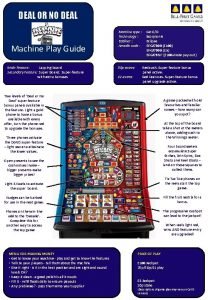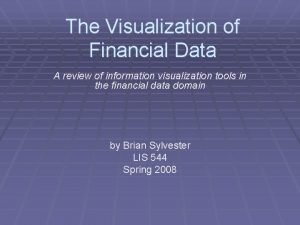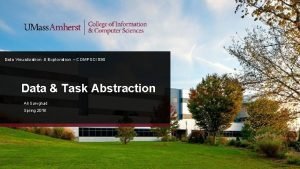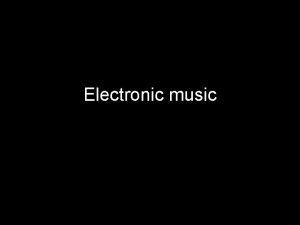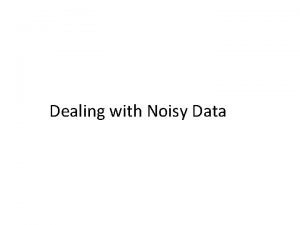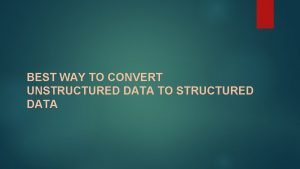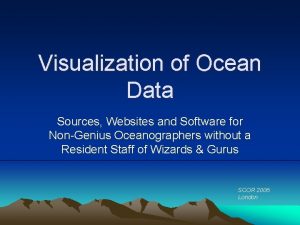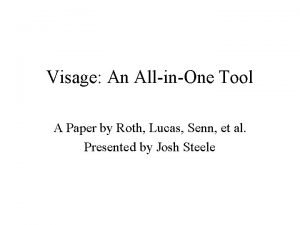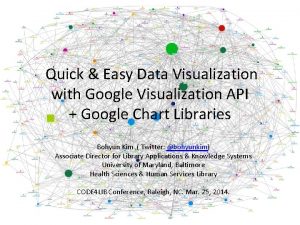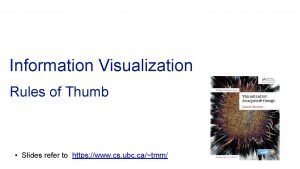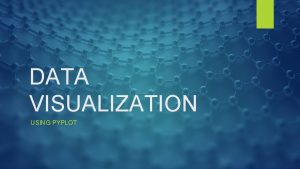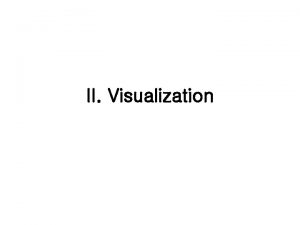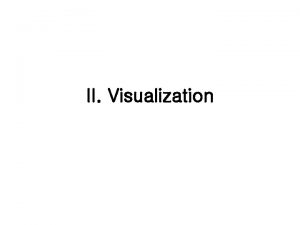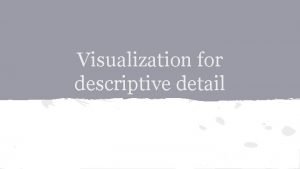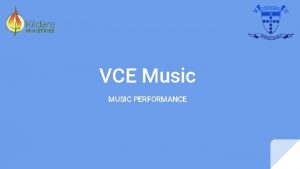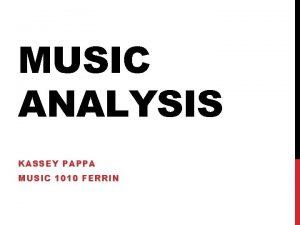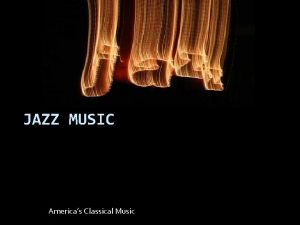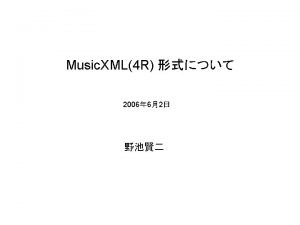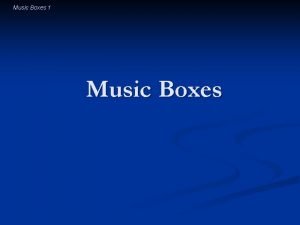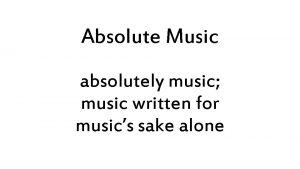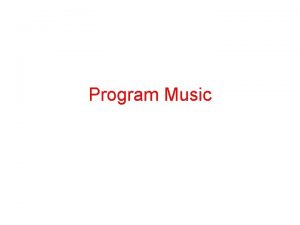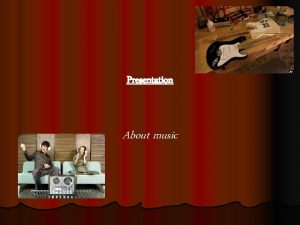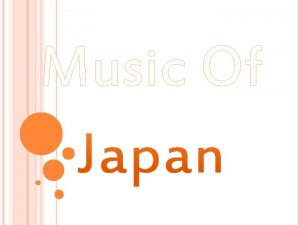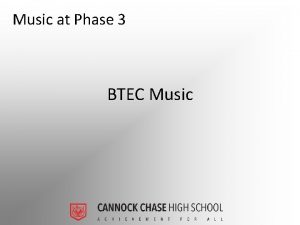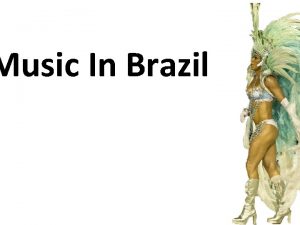VISUALIZATION OF MUSIC DATA VISUALIZATION TOOLS THAT DEAL











![MUSIC Music discovery tools 1. 2. 3. 4. 5. Music. Map [music-map. com] Music MUSIC Music discovery tools 1. 2. 3. 4. 5. Music. Map [music-map. com] Music](https://slidetodoc.com/presentation_image/fc77714fddb85939196a3f89bbdac50f/image-12.jpg)

![PROTOTYPE DISCOVERY TOOL LIVE PLASMA [www. liveplasma. com] -courtesy of ed tech toolbox PROTOTYPE DISCOVERY TOOL LIVE PLASMA [www. liveplasma. com] -courtesy of ed tech toolbox](https://slidetodoc.com/presentation_image/fc77714fddb85939196a3f89bbdac50f/image-14.jpg)



![PROTOTYPE RESEARCHER TOOL Ishkur's Guide to Electronic Music [http: //techno. org/electronic-music-guide/] -courtesy of DJ PROTOTYPE RESEARCHER TOOL Ishkur's Guide to Electronic Music [http: //techno. org/electronic-music-guide/] -courtesy of DJ](https://slidetodoc.com/presentation_image/fc77714fddb85939196a3f89bbdac50f/image-18.jpg)




![PROTOTYPE CONSUMER TOOL Hitlantis [www. hitlantis. com] - courtesy of tight mix blog PROTOTYPE CONSUMER TOOL Hitlantis [www. hitlantis. com] - courtesy of tight mix blog](https://slidetodoc.com/presentation_image/fc77714fddb85939196a3f89bbdac50f/image-23.jpg)


- Slides: 25

VISUALIZATION OF MUSIC DATA VISUALIZATION TOOLS THAT DEAL WITH MUSIC Mary Carter Information Visualization, § 554 Fall 2012

DEFINITION OF THE DATA SET MUSIC

DEFINITION OF THE DATA SET MUSIC Can be as complex as “the science or art of ordering tones or sounds in succession, in combination, and in temporal relationships to produce a composition having unity and continuity, ” or as simple as “an agreeable sound. ”

DEFINITION OF THE DATA SET MUSIC Can be as complex as “the science or art of ordering tones or sounds in succession, in combination, and in temporal relationships to produce a composition having unity and continuity, ” or as simple as “an agreeable sound. ” Or as simple as “an agreeable sound. ”

DEFINITION OF THE DATA SET MUSIC Can be as complex as “the science or art of ordering tones or sounds in succession, in combination, and in temporal relationships to produce a composition having unity and continuity, ” or as simple as “an agreeable sound. ” Or as simple as “an agreeable sound. ” “When we conceptualize music as information, we are referring to elements of music such as pitches, chords, tempo and dynamics on one level, and contextual information such as genres, performers, dates and instrumentation on another. ” -Margaret Lam

DEFINITION OF THE DATA SET MUSIC Can be as complex as “the science or art of ordering tones or sounds in succession, in combination, and in temporal relationships to produce a composition having unity and continuity, ” or as simple as “an agreeable sound. ” Or as simple as “an agreeable sound. ” “When we conceptualize music as information, we are referring to elements of music such as pitches, chords, tempo and dynamics on one level, and contextual information such as genres, performers, dates and instrumentation on another. ” -Margaret Lam Many of the visualizations rely heavily on context, i. e. the visualizing by genre or artist.

DEFINITION OF THE DATA SET MUSIC 20 tools were examined, and fell into three categories:

DEFINITION OF THE DATA SET MUSIC 20 tools were examined, and fell into three categories: 1. Music discovery tools

DEFINITION OF THE DATA SET MUSIC 20 tools were examined, and fell into three categories: 1. Music discovery tools 2. Tools for research

DEFINITION OF THE DATA SET MUSIC 20 tools were examined, and fell into three categories: 1. Music discovery tools 2. Tools for research 3. Tools for the consumer

DEFINITION OF THE DATA SET MUSIC 20 tools were examined, and fell into three categories: Music discovery tools
![MUSIC Music discovery tools 1 2 3 4 5 Music Map musicmap com Music MUSIC Music discovery tools 1. 2. 3. 4. 5. Music. Map [music-map. com] Music](https://slidetodoc.com/presentation_image/fc77714fddb85939196a3f89bbdac50f/image-12.jpg)
MUSIC Music discovery tools 1. 2. 3. 4. 5. Music. Map [music-map. com] Music Sun [http: //pampalk. at/Music. Sun/] current information and links NOT available Music Rainbow [http: //pampalk. at/Music. Rainbow/] current information and links NOT available Music. Lens [http: //www. dddsystem. com/produkte/musiclens/] PROTOTYPE: Liveplasma [www. liveplasma. com]

CHARACTERISTICS Music discovery tools are by far the most prevalent visualization tools for music. These tools can be manifested in a variety of ways: Treemaps: Most tools are hybrid visualizations, usually a combinations of flow charts, connection visualizations, and interactive visualizations ( see Live. Plasma, and Music Sun, and Music. Lens) These tools show relations amongst musicians. The idea is that, if a user likes one kind of music, he or she can use an artist or particular song to find similar music.
![PROTOTYPE DISCOVERY TOOL LIVE PLASMA www liveplasma com courtesy of ed tech toolbox PROTOTYPE DISCOVERY TOOL LIVE PLASMA [www. liveplasma. com] -courtesy of ed tech toolbox](https://slidetodoc.com/presentation_image/fc77714fddb85939196a3f89bbdac50f/image-14.jpg)
PROTOTYPE DISCOVERY TOOL LIVE PLASMA [www. liveplasma. com] -courtesy of ed tech toolbox

Perceptual Interaction Position x Direct Manipulation x Size x Immediate Feedback x Orientation Texture Shape Color x Shading Depth Cues Surface Motion Stereo x Continuity Connectedness Closure Containment • Color distinguishes between different kinds of electronic/different instruments associated in the making of the music • Only a connoisseur of the techno music industry would be able to digest everything on the page. • No direct manipulation with the data. Linked Displays Animate Shift of Focus x Dynamic Sliders Semantic Zoom Focus + Content Details on-demand Output Input x Info Density Proximity Similarity TOOLBOX FOR Music. Lens x Maximize data ratio x Maximize data density x Minimize Lie Factor X

MUSIC Music Viz Tools for Researchers 1. 2. 3. 4. 5. 6. 7. 8. Visualization of the last. gm dataset [http: //www. visual-telling. com/? p=18] Genealogy of Music and Pop Rock by Rebee Garofalo [http: //www. historyshots. com/rockmusic/index. cfm] Musicovery: [musicovery. com] Last. fm Heatmap Calendars [http: //dekstop. de/weblog/2011/09/lastfm_heatmap_calendars/] Last Graph [http: //lastgraph 3. aeracode. org/] Musician Map [http: //www. sfu. ca/~jdyim/musician. Map/] Music listening habits via streamed graphs [http: //www. leebyron. com/what/lastfm/] PROTOTYPE: Ishkur’s Guide to Electronic Dance Music [http: //techno. org/electronic-music-guide/]

CHARACTERISTICS Researchers are any users who are not using the following information visualization tools to enhance their own personal music taste, but instead are using the tools to further their knowledge for the purposes of proving a thesis (however tentative it may be). Research visualization tools are an amalgam of many different types of visualizations, including heatmaps (see Last. fm Heatmap Calendars), graphs (see Last Graph), maps (see Genealogy of Music and Pop Rock by Rebee Garofolo, Musicovery, Musician Map, and Ishkur’s Guide to Electronic Music)
![PROTOTYPE RESEARCHER TOOL Ishkurs Guide to Electronic Music http techno orgelectronicmusicguide courtesy of DJ PROTOTYPE RESEARCHER TOOL Ishkur's Guide to Electronic Music [http: //techno. org/electronic-music-guide/] -courtesy of DJ](https://slidetodoc.com/presentation_image/fc77714fddb85939196a3f89bbdac50f/image-18.jpg)
PROTOTYPE RESEARCHER TOOL Ishkur's Guide to Electronic Music [http: //techno. org/electronic-music-guide/] -courtesy of DJ Vibe

Perceptual Interaction Position x Direct Manipulation Size x Immediate Feedback Orientation Texture TOOLBOX FOR ISHKUR’S GUIDE TO ELECTRONIC MUSIC Shape Color x x Surface Motion Stereo Proximity Similarity Closure Containment • Color distinguishes between different kinds of electronic/different instruments associated in the making of the music • Only a connoisseur of the techno music industry would be able to digest everything on the page. • No direct manipulation with the data. Semantic Zoom Focus + Content Details on-demand Output Input Info Density Maximize data ratio x Continuity Connectedness Animate Shift of Focus Dynamic Sliders Shading Depth Cues Linked Displays Maximize data density Minimize Lie Factor x x

MUSIC Tools for the Consumer

MUSIC Tools for the Consumer 1. 2. 3. 4. 5. Music. Nodes [http: //www. musicnodes. no/About. Us. aspx] Zune Mix. View (retired) [http: //www. dailymotion. com/video/x 9 nmnh_microso ft-zune-mixview-ad_news#. UNGBl. Xd. QCig] Tuneglue [http: //audiomap. tuneglue. net/] Moody [http: //www. crayonroom. com/moody. php] PROTOTYPE: Hitlantis [hitlantis. com]

CHARACTERISTICS Consumer tools are very similar to music discovery tools, but their ultimate goals are different Consumer tools entice users to purchase music, and thus come with more added information, as well as the ability to share information about music preferences. Visualizations are most often nodal maps (Hitlantis, Music. Nodes), some are just interactive visuals (Zune Mix. View).
![PROTOTYPE CONSUMER TOOL Hitlantis www hitlantis com courtesy of tight mix blog PROTOTYPE CONSUMER TOOL Hitlantis [www. hitlantis. com] - courtesy of tight mix blog](https://slidetodoc.com/presentation_image/fc77714fddb85939196a3f89bbdac50f/image-23.jpg)
PROTOTYPE CONSUMER TOOL Hitlantis [www. hitlantis. com] - courtesy of tight mix blog

Perceptual Interaction Position x Direct Manipulation x Size x Immediate Feedback x Linked Displays x Orientation Texture TOOLBOX FOR HITLANTIS Shape Color Dynamic Sliders x Shading Depth Cues Surface Motion Stereo Proximity Similarity Continuity Connectedness Closure Containment Animate Shift of Focus x Hitlantis makes good use of color, but perhaps at the expense of other perceptual cues. There is quite a bit of interaction to be had, with rich feedback and details provided Semantic Zoom Focus + Content Details on-demand Output Input x x Info Density Maximize data ratio x Maximize data density x Minimize Lie Factor x

CONCLUSION From the above analyses of twenty music information visualization tools, it is apparent that most tools are used for music discover. All tools rely heavily on color as a method of conveying information. Very few tools are misleading, though some may not maximize data ratio and density, instead preferring too much “flare” over efficient presentation of information. Direct manipulation is a preferable, though not always present facet of many tools analyzed herein. Research tools make more use of a variety of different types of visualizations (graphs and heatmaps as well as nodal maps).
 Online music portfolio
Online music portfolio Deal or no deal machine
Deal or no deal machine Asset deal vs share deal
Asset deal vs share deal Music data visualization
Music data visualization Spotfire demo gallery
Spotfire demo gallery Phân độ lown ngoại tâm thu
Phân độ lown ngoại tâm thu Block xoang nhĩ là gì
Block xoang nhĩ là gì Thể thơ truyền thống
Thể thơ truyền thống Thơ thất ngôn tứ tuyệt đường luật
Thơ thất ngôn tứ tuyệt đường luật Walmart thất bại ở nhật
Walmart thất bại ở nhật Tìm vết của mặt phẳng
Tìm vết của mặt phẳng Hãy nói thật ít để làm được nhiều
Hãy nói thật ít để làm được nhiều Tôn thất thuyết là ai
Tôn thất thuyết là ai Gây tê cơ vuông thắt lưng
Gây tê cơ vuông thắt lưng Sau thất bại ở hồ điển triệt
Sau thất bại ở hồ điển triệt Task abstraction example
Task abstraction example Romantic time period
Romantic time period Beats organized in a recurring accent pattern
Beats organized in a recurring accent pattern Music that employs electronic musical instruments
Music that employs electronic musical instruments Pamulinawen music style
Pamulinawen music style How to deal with noisy data
How to deal with noisy data How to transform unstructured data to structured data
How to transform unstructured data to structured data Ocean data visualization
Ocean data visualization Visage data visualization
Visage data visualization Google visualization api query language
Google visualization api query language Data visualization rules of thumb
Data visualization rules of thumb

